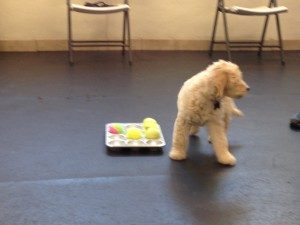Tired of the leash-walking “Tug of War”?! Here we use a foundation of focus and attention to build good leash-walking behavior. We also review the basics of training house manners, as well as teaching your dog to go to a mat to relax.
As always we open with:
RELAXATION / ATTENTION
- Shaping go to Mat
Clicking and treating for the offered behavior of going to the Mat. Marking and rewarding increasing approximations of the final desired behavior of going all the way to the Mat. - Clicking and treating for relaxation on a Mat
Marking increasing relaxation or calm behavior on the Mat.
INFORMATION
House Manners: What a Way to Go!
The puppy is three places:
- Under your direct supervision
- Crated or in a pen
- In the yard doing business
BEHAVIOR
Loose Leash Walking
Attention is at the heart of this behavior. Our steps assume that your dog will be walking on your left side. If you prefer your dog on your right side, just reverse the instructions.
- Hold the leash in your right hand, along with your clicker.
- The leash should be loose, forming a gentle “J”.
- Put 10 or 15 treats in your left hand.
- Start by standing!
- When your puppy enters the “Zone” near your left heel, click, and drop a treat by or a little behind your left heel.
- Repeat for several times until your puppy begins to seek out the Zone.
- Take a step, clicking and dropping a treat every time your puppy enters the Zone.
- Increase the number of steps before you click and treat ever so gradually to keep your puppy within the range of success.
Some variations will raise the difficulty level little bit by little bit. Remember that when you make one criterion harder, make the others easier again.
- Change direction.
- Change your speed.
- Pause in place and begin again.
CONFIDENCE / SOCIALIZATION
Confidence Course
HOMEWORK
- Practice Loose Leash Walking in a new location. Remember that three good steps are so much better than thirty steps on a tight leash.
- Look for features on your walks that can serve as parts of an Out-and-About Confidence Course.
QUICK NOTES FOR CLASS
Things to Bring
- Your Pup!
- Well-behaved children and spouses 8 or older.
- A flat collar, harness, or martingale collar.
- Lots of pea-sized soft treats in at least two different flavors. 200 tiny pieces are not too many. Some suggestions: Hot dogs, String cheese, Meatballs, Chicken or Tuna, Baby food (in a camping tube), Vienna sausages, Liverwurst, Thin-sliced Beef.
- A fanny pack, carpenter’s apron, or treat pouch to hold your 200 tiny pieces.
- A 6-foot leash.
- A mat, bathmat, towel, or blanket for your puppy or dog to rest on.
- Water and a bowl for when your pup gets thirsty.
Do's and Don'ts
- Do let us know if your pup has any food allergies so that we can be careful not to give him a troublesome treat.
- Don’t bring prong, choke, shock, or citronella collars.
- Don’t bring Flexi or other retractable leashes.
- Puppies and dogs should not meet while on leash in class, or while coming and going. There will be opportunities for off-leash play for compatible puppies, and good neighbor exercises for older pups and dogs.
- Don’t feed a heavy meal before coming to class. In fact, your in-class treats can serve as your dog’s breakfast on class day!
- If your puppy or dog is ill, please leave him at home to recuperate, but feel free to come to class without him so that you can learn what’s on the agenda for that day.
Puppy Kindergarten
“PUPPY K” RESOURCES
Puppy Topics
Puppy eBooks
- Ian Dunbar’s Before You Get Your Puppy
- Ian Dunbar’s After You Get Your Puppy
Training Video
HOMEWORK
Homework 1
- Play with your puppy.
- Catch your pup in the act of doing five different things you like. Click and Treat. Repeat.
Homework 2
- Have your dog “Wait” for you to put her food bowl down for each meal.
- Couple handling with treats a few times a day.
Homework 3
- Practice Loose Leash Walking in a new location. Remember that three good steps are so much better than thirty steps on a tight leash.
- Look for features on your walks that can serve as parts of an Out-and-About Confidence Course.
Homework 4
- Surprise your dog with ten treats in ten seconds at least three times a day.
- Practice the Name Game three times a day.
Homework 5
- Discover a new opportunity to help your dog choose an appropriate behavior.
- Write down the first five steps that you would train.


